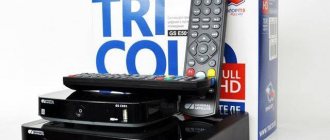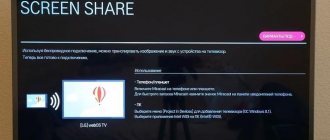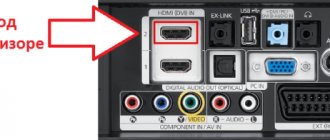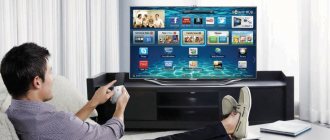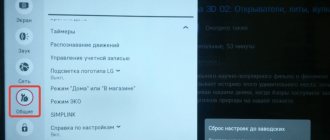Error 2003 on Samsung Smart TV is a frequent request from owners of TVs from a well-known manufacturer who have encountered this problem. Usually error appears due to a failure of the Samsung Apps online program. This is an electronic store that is built into all touch phones. You can use it to download various games and applications. Smart TV can be loaded with interesting widgets that make a person’s life easier. If a “Failed to load” notification appears on your TV screen when loading new software, indicating error 2003, read this article. Here we will describe possible causes of application failure and methods for eliminating them.
Fixing the error: User Profile Service failed to login
In this article we will look at all the options for solving user profile loading errors on Windows 7, Windows 10 and the Windows Server line starting from 2008 (most often on RDS servers). The error is quite common, usually associated with corruption of the user profile directory, but it can be fixed relatively easily.
The problem looks like this: the user profile service (ProfSvc) cannot load the Windows user profile, accordingly the computer user cannot log into the system, and after entering credentials an error window appears:
The user profile could not be loaded.
User profile cannot be loaded.
The profile loading error in the vast majority of cases is due to corruption of the user profile or rights to the profile directory. This may occur due to an incorrect system shutdown, system update, incorrect registry changes, or other failures.
Let's consider all the ways to solve the problem, starting with the simplest. For almost all solutions, you will need an account with local administrator rights on the computer. If you do not have another account on the computer where this error occurs and you cannot log in under a temporary profile, then you will need to boot from the bootable USB flash drive and create a new account.
The problem can arise for various reasons, so we are considering all possible solutions. If one option doesn't work for you, move on to the next.
Smart Hub - what is it?
Samsung Smart Hub is a kind of platform that contains built-in programs for Smart TV and additional programs can be installed here. Almost any TV with this platform has a browser and a utility for downloading applications from the official store installed here.
The service first appeared in the D5500 line of TVs, which means it is built-in in all newer versions. Initially, the platform came only with the Samsung branded store. More advanced models with Samsung Smart Hub can accommodate many more applications.
What does this platform for Smart TV include:
The platform can easily be expanded with additional applications. With factory settings, there may not be even half of the useful programs here. This is not scary, because using the remote control and searching in the store, it will not be difficult to set up Smart Hub.
Key thoughts: Smart Hub is not a separate application, but a platform on which other programs are hosted. The second key idea is that you need to customize the service yourself.
1. Editing profile parameters in the registry
Run the registry editor regedit with administrator rights and go to the registry key HKEY_LOCAL_MACHINE\SOFTWARE\Microsoft\Windows NT\CurrentVersion\ProfileList .
You will see a list of sections (profiles) with a name in the form S-1-5-21-xxxxxxx. These are user identifiers (SIDs), by any of them you can find out the account name (for example, the following command can display a list of local users and their SIDs: wmic useraccount get domain,name,sid ).
You can simply find the profile of the problematic user by sequentially going through all the branches with SID in the ProfileList section. In the desired branch, the user account must be present in the profile path in the ProfileImagePath .
There are several options:
After you have renamed the branch of the desired profile, you need to edit the value of the RefCount and State parameters. Set their values to . If you don't have such parameters, create them manually (DWORD type).
Make sure that the ProfileImagePath value specifies the path to the correct profile directory, and that the profile folder itself is present on the disk and has the same name as in ProfileImagePath. In my case it is C:\Users\root.
After this, restart your computer and try to log in using your user profile.
Reset Smart Hub settings
Resetting Smart Hub removes all downloaded apps and resets them to factory defaults. When you reset, all data and application settings are deleted, along with errors.
Before resetting Smart Hub, make sure your TV is certified for Russia. Look at the factory sticker of the TV; the model code of the certified equipment must end with the model code XRU and the EAC icon.
If the model is not for Russia, after resetting the Smart Hub may be blocked.
Select "Support".
Select "Self-diagnosis".
Select Reset Smart Hub.
Enter the TV PIN code (default 0000).
Wait for the reset to complete.
After the reset, exit the menu. Go to the main screen, select the "APPS" panel. A new window will appear with initial setup information, click OK.
Select “I Accept All” and click “OK.”
Sign in to your Samsung account or click Skip.
Select the apps you want to install and click Finish.
After the reset, try launching the application.
Before launching applications, make sure that all pre-installed applications have loaded. Their icons should not be highlighted in a dark color.
The download speed of the application depends on the speed of your Internet connection.
If the application works, then everything is fine with the TV, continue using it. If the app doesn't work, move on to the next recommendation.
2. Restoring the Default profile by replacing the damaged NTUSER.DAT file
If the error “Unable to load user profile” occurs the first time the user logs into the system, then the problem with loading the profile may be due to a damaged NTUSER.DAT in the Default profile. This file stores user settings, those parameters that are loaded into the HKEY_CURRENT_USER registry key when the user logs in. When you create a profile for a new user, this file is copied to the directory with the created user profile. If the NTUSER.DAT file is deleted or corrupted, the User Profile Service cannot create a profile for a new user.
Go to the C:\Users\Default directory. It will contain the file NTUSER.DAT, rename it, for example, NTUSER.DAT2. Next, you will need to replace this file with a similar file from another user’s profile, or a file from another computer (with the same version of Windows). After this, reboot the system, and if the problem was a corrupted NTUSER.DAT, then everything should work.
There is also advice on the Internet to replace the entire C:\Users\Default folder, but the essence remains the same, the point is to replace the NTUSER.DAT file, which changes when the folder is replaced.
3. Restoring Windows from a restore point
If you have restore points enabled and configured in Windows, you can try to solve the error by restoring to a previous restore point.
In the control panel, go to the Recovery .
Next, click Open System Restore .
And follow the instructions of the wizard (click next several times), after which the system will begin recovery.
Creating a new user and transferring old data
If other options do not help you, you can create a new user and transfer the data from the old profile to it. This method will definitely work, since we will be creating a new user with a new profile.
Points 3 and 4 apply to Windows 10, if you have Windows 7, then just skip them and go to point 5.
Don't forget to enable the display of hidden files and folders.
With this recovery method, you do not lose the data that was in the old profile. If there are problems copying, you can always access the data from the old profile simply by going to C:\users\your_old_profile
Once you are successfully logged in with your new profile, make sure you have access to your old files, for example in your Downloads or Documents folder. If there is no access (an error pops up with access denied), you will need to give RW or FullControl rights to these folders to your new user.
Change the DNS server address
In addition to the provider, the problem may be in the DNS server. To check this, change the DNS server address on the TV.
Select "General" if your TV has it. If there is no such item, go to the next step.
Select "Network".
Select Network Status.
Make sure Internet access is available.
Select "IP Settings".
Click on "DNS Settings" and select "Enter Manually".
Select the “DNS Server” field and enter 8.8.8.8 or 208.67.222.222. Click Done, then the Back button.
Click "OK" to save the settings.
After saving the settings, make sure that the TV is connected to the Internet.
Reboot your TV and check the application after reboot.
If the application works, then everything is fine with the TV, continue using it. If the app doesn't work, move on to the next recommendation.
Read permissions for the directory C:\Users\Default
Problems with the lack of rights to read the Default user profile are more common in Windows Server. When you try to log into the system on Windows Server 2008 and higher, you may encounter a similar error. In the error log you can see the corresponding error with ID 1509.
To fix, simply give the Users group read permissions to C:\Users\Default as follows.
If the error is not resolved, check the Windows error log for similar errors, for example, ID 1500 , which is associated with corruption of the NTUSER.DAT file (solved by option #2 in this article).
Recommendations for troubleshooting the problem
Almost always, the problem with loading a profile is associated with incorrect profile data in the registry, or damage to the NTUSER.DAT file, so eliminating the error involves restoring these resources to their previous state.
Following this article, first try to correct the profile paths in the registry and the ntuser.dat file. Usually these steps are enough to restore your profile to functionality. Some articles recommend logging into safe mode, but this is not necessary since this problem is not related to drivers.
The most difficult option is when you cannot get into your profile, you do not have another administrative account, and the system does not create a temporary profile. That is, you cannot log into Windows in any way. To solve the problem, you will need a bootable USB flash drive (or at least an installation disk) with your version of Windows, you need to boot from it and create a new account with administrator rights. Then follow the steps described in the article.
Source
Instructions for setting up Smart TV with Smart Hub
The user will need help setting up Smart TV. To make sure you don’t get confused in this process, we have compiled detailed instructions.
- We connect Smart TV to the Internet. This can be done using an Ethernet cable, Wi-Fi or modem. The most convenient way to connect is Wi-Fi. It’s just important to check that the connection quality is high and the speed is not lower than 20 Mb/s.
- Turn on the TV screen and in the main menu press “Smart” on the remote control. The menu from Smart Hub should open. Healthy! If you don't have a TV remote control, you can use a smartphone with the TV Remote Control app or similar.
- We synchronize with TENET-TV. In the Smart Hub, press the “D” (or “Tools”) key on the remote control and in the “Settings” section click on “Development”.
- Go to “IP Address Settings” and set the IP from Smart Hub - 195.138.78.68.
- We register the TV in the form that appears in the main Smart Hub menu, if necessary.
Important! If the TENET-TV element is not displayed, press the “Smart” button on the remote control twice.
That's all, now we can go to the Samsung store and download any applications for watching videos, searching for information on the Internet and playing games. As you can see, there is nothing complicated. True, there are exceptions when downloaded applications refuse to launch, but in this case we have a solution.
Symptoms
After you install the Vulnerability in Windows User Profile Service update, privilege escalation may be possible: January 13, 2015 (MS15-003), you may be able to resolve the following issues:
Profiles are not loaded the first time users log on to their computer. Or you log on to a computer where the policy deletes the cached profile after a date interval when you log off.
This may also impact user accounts that use mandatory user profiles or virtual desktop infrastructure (VDI).
Profiles are not loaded when users log in using cached user profiles.
Services do not start due to profile loading failures. Affected services include:
When this issue occurs, related events are logged. View events logged in Event Viewer.
The Process Monitor may indicate that the CreateFile with the result ACCESS DENIED in the following path, depending on the file access restrictions: :\documents & settings\\local settings\Application Data\Microsoft\Windows\UsrClasss.dat.
A screenshot of the process monitor can be seen here:
How to fix the error?
Let us immediately note that this error most often appears in Windows 7, but is not limited to this operating system. It can also appear in Windows 10, 11, but much less frequently. In each case, the reasons and remedies are similar. We recommend following the instructions strictly, since the first methods are the most effective and easiest to implement. At the end are those procedures that should work in more complex situations.
1) Enable Cryptography service
The cryptography service is important for verifying file certificates. However, it is not needed often, so some users disable the service without knowing about its functions. Sometimes programs also turn it off, especially those designed to speed up system performance. Such savings are fraught with the inability to install important software and the penetration of viruses into the system; it is better to enable the function again.
What to do when “the cab file is not trusted” when installing DirectX:
- Open Start and enter “Control Panel” into the search, open the only option found.
- Click on “Administration” and select “Services”.
- If you are sorting by name, scroll through the list almost to the end and find “Cryptography Services”.
- Double-click on it, click on the “Launch” button and in the “Startup type” line set the value to “Automatic”.
It’s worth trying the installation; if the service was turned off, it should go through without problems. At least for most users.
2) Clean up residual DirectX files before installation
We've seen a lot of reports that some people have found it helpful to clear out all the old files left over from previous versions of DirectX or the NET Framework. Considering the comparative simplicity and minimal risks of the procedure, it’s definitely worth a try.
How to fix the “cab file is not trusted” error:
- We go to the path \Windows\System32\directx\ or \Windows\SysWow64\directx depending on the bitness of the Windows 7 operating system.
- Click on the “File” button, then “Arrange” and click on the “Folder and search options” item.
- On the “View” page, activate the “Show hidden files and folders” flag and click on the “Apply” button.
- The websetup folder should appear, open it and delete all contents.
- Re-launch the online or offline installer.
3) Restore services to default Windows 7
As we have already mentioned, there are exceptions to all rules and there are quite a few of them. Cryptographic services may not start or may fail to function due to corruption, incorrect state, etc. However, there is a way to restore them to their default state. On Windows 7 this is done this way:
- Download this software from the official Microsoft website.
- Unzip the PsTools program to any convenient location.
- Move PsExec.exe to the C:\Windows\System32 folder.
- Launch the command line with administrator rights.
- Enter the command psexec -i -d -sc:\windows\regedit.exe . If this is your first time running the tool, you need to select the Agree .
- Now comes the relatively difficult step - you need the servicedefaultregistryentries.reg file. It is difficult to find on the Internet, and those found cannot be trusted (there is no guarantee of safety). The best option, but longer, is to install the same operating system via VirtualBox and export the registry.
- Open the “Registry Editor”, to do this press Win + R, insert regedit and press Enter.
- In the “File” tab, select “Import” and specify the path to the servicedefaultregistryentries.
- Reboot the computer to make sure it works.
Solution
To resolve this issue, follow these steps:
Check if the Read ONLY flag is set in NTUSER. DAT or USERCLASS. DAT file for a profile that cannot be loaded.
New user profiles are derived from C:\users\default\ during the first logons of the account. If profiles do not load with signatures that match those described in the Symptoms section, check whether the Read-Only bit is enabled in NTUSER. DAT and USRCLASS. DAT files in the profile directory for users or service accounts.
NTUSER. The DAT in Windows Vista and later versions of Windows is located in C:\users\default\ntuser.dat. Earlier operating systems have different paths, such as C:\Documents and Settings\\ntuser.dat.
The USRCLASS. The DAT file is usually located at C:\Documents and Settings\Local Settings\Application Data\Microsoft\Windows\UsrClass.dat or C:\Users\AppData\Local\Microsoft\Windows.
In Windows Explorer, right-click NTUSER. DAT or USRCLASS file for the corresponding default user or cached user profile. Needs to be cleared for read-only . It will be selected, causing the profiles to fail to load.
Contact the application developer
If the above recommendations do not help and the application still does not work, contact its developer.
Typically, contacts are listed in the detailed description of the application in Samsung Apps, for example for YouTube. To open the detailed description of the application, find it in the Samsung Apps store, then select the button on the screen in the form of three dots
.
In the window that opens, try to find the developer’s contacts: usually a website or email.
If you have an app on your Samsung Smart TV that is not working properly, follow these steps.
additional information
Events are logged in the Event Viewer log
Details of the failure displayed in Process Monitor
ProMon detailsThe following message is displayed in Process Monitor:
Desired access: universal read-write mode, location: open, parameters: synchronous IO without notification, file without directory, attributes: H, ShareMode: Read, write, AllocationSize: n/a, substitution:
The following screenshot shows the process monitor details:
Source
Windows couldn't log you in because it couldn't load your 2003 profile.
When you try to log off from a computer that is running Windows Server 2003, Windows XP, Windows 2000, or Windows NT 4.0, you experience one of the following symptoms. — The user profile is not loaded. — The profile being moved is not consistent. — The registry size reaches the maximum allowed value. — Logging out takes a long time and the display shows the following message: Saving settings. Additionally, one or more of the following events are logged in the Application event log:
Windows XP and Windows Server 2003
Type: Error Source: Userenv Category: None ID: 1517 Description: The user computername/username registry was saved while an application or service continued to use it during logout. Memory used by the user registry has not been freed. The registry will be unloaded when not in use. A possible cause is services running on behalf of the user. Try changing the services configuration to run them under the LocalService or NetworkService accounts.
Type: Error Source: Userenv Category: None Code (ID): 1524 Description: Windows was unable to unload the class file from the registry - it is being used by other applications or services. The file will be unloaded when it is not in use.
Type: Error Source: Userenv Category: None Code (ID): 1500 Description: Windows was unable to sign you in because your profile could not be loaded. Check that you are connected to the network and that the network is working properly. If the problem persists, contact your system administrator. Details: —————————— Access denied
Type: Error Source: Userenv Category: None Code (ID): 1000 Description: Failed to unload your registry file. If you are using a roaming profile, your settings are not replicated. Contact your system administrator. Details: —————————— Access denied
Type: Error Source: Userenv Category: None ID: 1000 Description: Your registry class file could not be unloaded. If you are using a roaming profile, your settings are not replicated. Contact your system administrator. Details: —————————— Access denied
Type: Error Source: Userenv Category: None Code (ID): 1000 Description: The operating system was unable to load the user profile. Contact your network administrator.
Type: Error Source: Userenv Category: None Code (ID): 1000 Description: The operating system was unable to load the user profile. Contact your network administrator. Details: —————————— Access denied.
Cause This behavior occurs if Windows or a third-party program (such as a printer driver or antivirus program) does not stop and release resources when the user logs off.
Solution To resolve this issue, use the Microsoft User Profile Hive Cleanup Service (UPHClean). The UPHClean service monitors the computer during the user profile unloading process and closes open resources. This allows the computer to unload and then negotiate user profiles.
Source
Causes
If your Samsung Smart TV displays error 2003, determine the reason before taking any action. Sources of malfunction may be the following:
- no contact with the server;
- lack or failure of network connection;
- TV system braking;
- router operation intermittently;
- need to update TV software.
If you identify one of the problems, see below for how to fix it.
Windows couldn't log you in because it couldn't load your 2003 profile.
General Discussions
When booting the laptop, instead of the user account, 2 messages pop up:
The user profile could not be loaded, so you are logged in using the default system profile.
The thing is that I only have a local profile and don’t have anything that can be moved.
Help me fix THIS.
All answers
The installation was made to the same partition where win7 corp lived before and where win vista home prem sp1 lived before.
the Documents&Settings folder exists, but is not available for any actions. The security tab is missing.
Formatting the partition and then installing it into a clean win xp is not an option.
Check group membership in Guests, Domain Guests
There should only be a Guest of Green Rent IT PE (https://rent-it.net.ua)
does the problem occur for a user with an existing profile or without a profile when the user logs in for the first time?
in the first case, the Default User is damaged; in the second, the user profile is damaged and either check the disk for errors (most likely not written to the user’s registry files) or rename the old profile and after creating a new one, transfer the blog.wadmin.ru data from it
The installation was made to the same partition where win7 corp lived before and where win vista home prem sp1 lived before.
the Documents&Settings folder exists, but is not available for any actions. The security tab is missing.
Formatting the partition and then installing it into a clean win xp is not an option.
Correcting a User Account Profile To correct a user account profile, follow these steps.
Attention! This section, method, or task includes information about changing registry settings. However, changing them incorrectly can lead to serious problems. Therefore, it is recommended that you strictly follow the instructions when performing these steps. For added protection, back up your registry. In this case, if problems occur, the registry can be restored. For more information about backing up and restoring the registry, see the following Microsoft Knowledge Base article: 322756 Backing up and restoring the registry in Windows Backing up and restoring the registry in Windows
Select Start, type regedit in the Search box, and then press Enter. In Registry Editor, locate and select the following subkey: HKEY_LOCAL_MACHINE\SOFTWARE\Microsoft\Windows NT\CurrentVersion\ProfileList In the navigation pane, locate the folder that begins with S-1-5 (SID key) followed by a long number. Click each of the S-1-5 folders, find the ProfileImagePath entry in the details pane, and double-click it to verify that it is the failed user account profile.
Source
